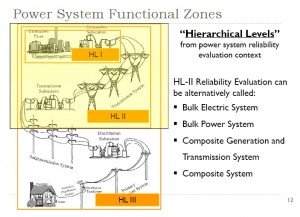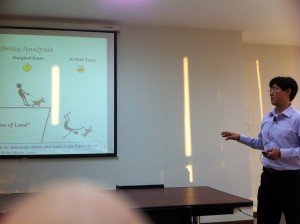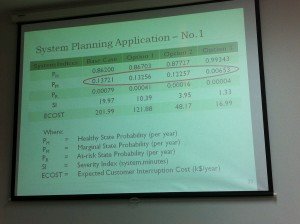วันที่ 10 มกราคม 2556 นี้จะมีการบรรยายเรื่อง Bulk Electric System Reliability Simulation and Application
โดยวิศวกรอาวุโส ซึ่งรับผิดชอบในหน่วยงานที่เรียกได้ว่า กฟผ. แคนาดา เลยค่ะ จึงขอประชาสัมพันธ์เพื่อประโยชน์ต่อผู้เกี่ยวข้องกับเรื่องเทคนิคเชิงลึกนี้ค่ะ ^^
Description: Bulk electric system reliability becomes an increasingly important topic in the changing electric power environment driven by the restructured and open access paradigm that creates greater uncertainties due to unbundled electric system with heavy system utilizations, market conditions, asset conditions, intermittent generations such as wind and solar energy, etc. Due to greater uncertainties, deterministic criteria currently used in power industry cannot adequately address various planning and operating uncertainties. There is, therefore, a need to re-design and apply deterministic techniques that include probabilistic considerations in order to assess the increased system stress and uncertainties. This presentation aims at providing a fundameental concept of power system reliability evaluation of bulk electric system and introducing a system well-being analysis approach that is a complementary way of incorporating deterministic engineering judgments into a probabilistic analysis framework. The utilization of system well-being analysis technique is illustrated using two system planning applications on the small practical test systems.
Duration: One hour presentation
Time and Place: January 10, 2013 at 4:00pm at the TGGS, KMUTNB.
Biography: Wijarn Wangdee obtained the Bachelor of Engineering degree in Electrical Engineering from Chulalongkorn University, Thailand. In 2000, he joined the Power System Research Group at the University of Saskatchewan in Canada where he recieved the Master of Science and Doctor of Philosophy degrees in Electrical Engineering with specialization in Power System Reliability. Since early 2006, He has worked in the System Planning Department at British Columbia Transmission Corporation and BC Hydro in Vancouver, Canada. His current position is a senoir system planning engineer. He has published more than 30 technical papers and written more than 40 internal technical reports in power system planning and reliability evaluation. He is a Senoir Member of the IEEE.

BC Hydro and Power Authority, Canada
Contact info: [email protected], [email protected]
ถ้าต้องการสำรองที่นั่ง โปรดติดต่อที่ Asst. Prof. Dr. Thanapong at the TGGS ค่ะ
————————————————————————————————
สามารถคลิ๊กเว็บเพจเพื่ออ่าน presentation ค่ะ
จากที่ฟังการบรรยายในครั้งนี้ พบว่า เป้าหมายหลักของอาจารย์ คือ การระบุปริมาณ (Quantitative/Probablilistic Analysis) ของเหตุการณ์/ทางเลือกที่จะเกิดในระบบควบคุมกำลังไฟฟ้าให้ได้ว่าเกิดขึ้นบ่อยแค่ไหน ผลกระทบมากน้อยแค่ไหนต่อความมั่นคงระบบไฟฟ้า โดยขอบเขตการศึกษา HL II แสดงในภาพค่ะ เนื่องจากการวิเคราะห์ในปัจจุบันส่วนใหญ่เป็นการระบุว่า Yes/No หรือเรียกว่าแบบ Deterministic Analysis ซึ่งจะเป็นวิธีที่จะตอบโจทย์สถานการณ์เช่นปัจจุบันที่มีการเปลี่ยนแปลงเกิดขึ้นได้เสมอจากหลายปัจจัยรอบด้าน ทั้งจากนโยบายรัฐบาล สิ่งแวดล้อม การยอมรับของประชาชน ความต้องการปริมาณไฟฟ้า (Demand) ความสามารถการจ่ายไฟฟ้า (Supply) พีคโหลด (Peak Load) แต่ละช่วงเวลา แหล่งเชื้อเพลิง ชนิดโรงไฟฟ้าที่เข้าระบบใหม่โดยส่วนใหญ่จะเป็น Renewables เป็นต้น

สิ่งที่ผู้เขียนสนใจมาก คือ การวิเคราะห์ที่แยกระหว่างความเสียหายของการที่จะเกิดกับผู้ใช้ไฟฟ้า Aqadacy Cost: Expected Customer Interruption Cost (ECOST) ซึ่งอาจารย์ระบุว่าแคนาดามีการทำข้อมูลจากการสำรวจ และ Security Cost: Expected Potential Insecurity Cost (EPIC) คือ ความเสียหายจากความไม่มั่นคงระบบไฟฟ้า
ความรู้ที่น่าสนใจ คือ ระบบกำลังไฟฟ้าของแคนาดาใช้ N-1 เหมือนประเทศไทยเรา แต่อย่างเช่น New York City ใช้ N-2 ซึ่งการตัดสินใจว่าจะเป็นระบบอะไร ย่อมมีเรื่องการตัดสินใจเรื่องการลงทุนระดับประเทศ หรือระหว่างประเทศกันทีเดียว เพราะเงินลงทุนของการเพิ่มกำลังการผลิตที่มากมหาศาล ปัจจุบันคงบอกได้แต่เพียงคร่าวๆ เช่นที่เกาะแมนฮัตตัน ว่าความเสียหายจากไฟฟ้าดับคงยอมให้เกิดไม่ได้ เมื่อเทียบกับความเสียหายของเมืองธุรกิจดังกล่าว
การผลิตไฟฟ้าจากน้ำของประเทศแคนาดาซึ่งใช้น้ำสัดส่วนสูงมากกว่า 90% ของการผลิตไฟฟ้าทั้งหมดนั้น ได้ส่งเข้ามาใช้ยังแคลิฟอร์เนียในช่วงพีคที่นั่น และเป็นความลงตัวที่ช่วงพีคของแคนาดา และแคลิฟอร์เนียร์ไม่ใช่เดือนเดียวกัน เช่นเดียวกับที่ประเทศไทยเดินเครื่องเขื่อนผลิตไฟฟ้าให้เหมาะสมตามเวลาพีคที่ควรเดิน
และการซื้อขายไฟฟ้าระหว่างประเทศใช้เป็นลักษณะของ MOU ไม่เหมือนสัญญาเข้มระหว่างไทยเรากับมาเลเซีย อันนี้น่าสนใจศึกษาประวัติศาสตร์ระหว่างประเทศเค้าค่ะเพราะดูเหมือนเป็นการบริหารทรัพยากรร่วมกัน มองเป็นภูมิภาค ไม่ได้มองแยกเป็นประเทศเรา ประเทศเค้า
*** รอยต่อตรง “การมีไฟฟ้าใช้พอ” กับ “ความมั่นคงในระบบไฟฟ้า” เป็นสิ่งลางเลือนมากไม่สามารถระบุได้ชัดเจน ดังเช่นที่เราได้ยินอยู่เสมอที่เมื่อไหร่มีเหตุการณ์ที่จะสามารถกระทบระบบกำลังไฟฟ้าได้นั้น เหมือนกับการปาหินเข้าถ้ำของคำว่า “ความมั่นคงระบบไฟฟ้า” ***



